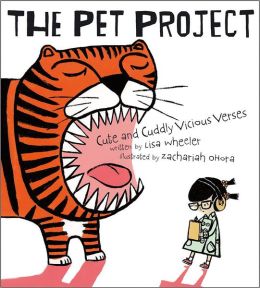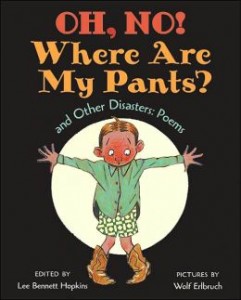The Pet Project
 As soon as I picked up this new poetry book, The Pet Project, I thought of the animal reports many of my students are doing and I knew I must get this book into the hands of those kids and their teachers! The Pet Project: Cute and Cuddly Vicious Verses written by Lisa Wheeler and illustrated by Zachariah Ohora begins with this ominous verse:
As soon as I picked up this new poetry book, The Pet Project, I thought of the animal reports many of my students are doing and I knew I must get this book into the hands of those kids and their teachers! The Pet Project: Cute and Cuddly Vicious Verses written by Lisa Wheeler and illustrated by Zachariah Ohora begins with this ominous verse:
Warning!
If you’re the type who oohs and ahhs
at furry faces, precious paws,
the words ahead may be alarming:
Animals aren’t always charming.
Considering that I’ve been giving stacks of informational animal books to teacher-friends for student research projects, this poetry book comes at exactly the right time. It’s poetry month (hello, Range of Reading Standard!) and each poem about a different animal just begs to be compared to an informational book that will confirm the cool, and sometimes gross, facts. (Integrating Knowledge and Ideas? Check!)
For example, if you’ve got students who’re interested in monkeys, share this gem:
Monkey
He looks so like a little man
with smiling teeth and grasping hand.
He chatters to his monkey friends,
but that is where the likeness ends.
His hair is full of bugs and lice.
He flings his poo – His aim’s precise.
His scream sounds like a banshee’s wail.
He swings from his prehensile tail.
And worst of all he smells so funky.
If he’s a man, then I’m a monkey!
After your students calm down from giggling over poo-flinging, the research-sparking discussion can begin. Do monkeys really fling poo? What does prehensile mean? Do monkeys really smell funky? Time to pull out the informational non-fiction books for a fact-finding expedition. I love that Wheeler never dumbs down her vocabulary (you’ll find query, devise, and formulate all in the second poem). Discussing all the wonderful words she chose will help you hit the Craft and Structure Standard. So one little picture book can help you teach three Common Core State Standards, kick off student-led research projects, enrich vocabulary, and strengthen the love of poetry. I think we’ve just found a new teacher’s pet in The Pet Project.
For more information on the author, please visit: lisawheelerbooks.com.For more information on the illustrator, please visit: zohora.com.
Read MoreDear Hot Dog
 When writing poetry with kids, one of the biggest complaints I hear is “I don’t know what to write about.” I can’t blame them. There are plenty of times when I look at a blank sheet of paper and I don’t know what to write about, either.
When writing poetry with kids, one of the biggest complaints I hear is “I don’t know what to write about.” I can’t blame them. There are plenty of times when I look at a blank sheet of paper and I don’t know what to write about, either.
That’s one reason why Dear Hot Dog by Mordicai Gerstein is so brilliant: he writes poems about the most ordinary of things, like a hot dog, the summer sun, even the air, all the things we love but sometimes overlook.
Take, for instance, Gerstein’s poem about socks (which is still apropos in April in Michigan):
Socks
I never stop
to think about socks,
and if I get them
for a birthday present
from Aunt Adi,
I’m disappointed.
You can’t play
with socks.
But now,
with wind rattling
the icy windows,
putting on these
soft, thick, red ones
makes me happy
all day.
I’ve said it before and I’ll say it again: poetry is meant to be read aloud. During this month of poetry (or any time of the year), read Dear Hot Dog to your students. (You’ll hit the Common Core Standard of Range of Reading, and if you focus on the poet’s choice of interesting words, you’ll teach Craft & Structure as well!) Talk about how each poem is an ode of gratitude for an everyday object. Take inspiration from Gerstein and brainstorm with the class all the ordinary stuff we love. A few of Gerstein’s poems have to do with food. In lousy-weather months when we can’t get outside, working food into a lesson will light up your Nature Smart Students. Perhaps everyone can bring in a favorite food as inspiration, to savor as they write their own poems about the taste, texture, smell, general wonderfulness of an everyday thing they love. Your students may find the extraordinary in the ordinary.
Read MoreOh, No! Where Are My Pants? and Other Disasters: Poems
 Poetry doesn’t have to be “roses are red, violets are blue…” As David Lubar wrote in his young adult novel, Sleeping Freshmen Never Lie, “There are as many types of poems as there are types of food. As many flavors, you might say. To claim you don’t like poetry because you hate ‘mushy stuff’ or things you don’t immediately understand is like saying you hate food because you don’t like asparagus.”
Poetry doesn’t have to be “roses are red, violets are blue…” As David Lubar wrote in his young adult novel, Sleeping Freshmen Never Lie, “There are as many types of poems as there are types of food. As many flavors, you might say. To claim you don’t like poetry because you hate ‘mushy stuff’ or things you don’t immediately understand is like saying you hate food because you don’t like asparagus.”
April is National Poetry Month, but don’t relegate poems to just one month – share all kinds of poetry all year long! (If you do, you can check Range of Reading off your Common Core Standards list!) One of my go-to poetry books is Oh, No! Where Are My Pants? and Other Disasters: Poems edited by Lee Bennett Hopkins with pictures by Wolf Erlbruch. These “disaster” poems range from funny to poignant, and your kids will find at least one to which they can totally relate.
For example, here’s one titled “Oh, No!” by Katie McAllaster Weaver:
“Hello apple!
Shiny red.
CHOMP. CHOMP.
Hello worm.
Where’s your head?”
and here’s part of one called “My Friend is Gone” by Lillian M. Fisher:
“A hug, a tear, and you are gone.
Your swing is missing from the lawn.
Your house is silent, dark and lone.
Your window says no one is home.”
Poetry is meant to be read aloud, so read Oh, No! Where Are My Pants? and Other Disasters: Poems to your class and then choose one or two of your favorite poems to read aloud again. Talk with your students about why you liked that particular poem. Encourage your students either to choose a poem to practice reading or to write a disaster poem of their own. Then, have a disaster poetry slam where you and each of your students read a poem aloud expressively to the class. You can bring a stool for kids to sit on, and a beret to wear, and students can snap for each other instead of clap (I like to teach them phrases like “cool cat” and groovy, man” because it makes me giggle.) Your students will build their reading fluency (another Common Core Standard checked off!) and find that poetry isn’t just mushy love stuff.
Read More
Lemonade and Other Poems Squeezed from a Single Word
 I know, I know, it’s September, we should be discussing fall titles, but here in Michigan it’s a glorious sunny day, perfect for Lemonade and Other Poems Squeezed from a Single Word written by Bob Raczka and illustrated by Nancy Doniger. Using only the letters from a single word, Bob Raczka makes short, sweet poems. (In the book, Raczka and Doniger show the long word, the letters falling, and how the letters rearrange to make new words, but for the sake of brevity I’m tightening the line spaces here. Use your imagination.)
I know, I know, it’s September, we should be discussing fall titles, but here in Michigan it’s a glorious sunny day, perfect for Lemonade and Other Poems Squeezed from a Single Word written by Bob Raczka and illustrated by Nancy Doniger. Using only the letters from a single word, Bob Raczka makes short, sweet poems. (In the book, Raczka and Doniger show the long word, the letters falling, and how the letters rearrange to make new words, but for the sake of brevity I’m tightening the line spaces here. Use your imagination.)
Spaghetti: papa has a pasta appetite he eats heaps
Earthworms: a short storm worms here worms there wear shoes
Share this book with your students and you’ll squeeze in three of your Common Core State Standards for reading: Range of Reading (because you’re sharing poetry), Print Concepts (recognizing all the letters of the alphabet, understanding how letters form words), and Fluency (these simple poems will be read and reread easily). To show how Raczka squeezed poems from words, write one of the words he chose on a large whiteboard. Use magnetic letters to spell the word again below your written word, and then begin rearranging those letters. Encourage your students to call out words they could make, or let them come up and arrange the letters themselves to make new words. Keep a running list on your white board of the words you formed. Now, can your class make a sentence using just those words, or a poem?
Students can use this as a writing prompt in a high-tech or low-tech way. In a large font, you can print off words for students to cut apart into letters they can manipulate, perhaps their names, vocabulary from a science or social studies unit, etc. and see if students can form words, sentences and poems. If you have access to iPads, you can download the Magnetic ABC iPad app (free for all capital letters, $1.99 for lowercase letters, numbers, and symbols). I like this app better than using real magnet letters because you always have as many of each letter as you need, and none of them get lost under the refrigerator or shelves. On the iPad, students can arrange the letters to make words as well, keeping a list of words they’ve made on Notepad ( a free app that comes on the iPad) and using that list to write poems.
Any time of the year, Lemonade and Other Poems Squeezed from a Single Word invites readers in for a refreshing sip of poetry.
For more information, visit Bob Raczka’s website: bobraczka.com or Nancy Doniger’s website: nancydoniger.com.
Read More






